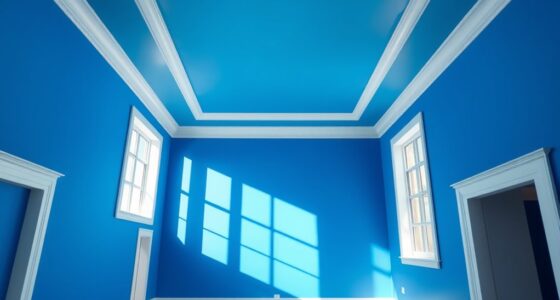Using sophisticated shades of purple in your decor instantly adds a touch of luxury, elegance, and cultural richness. Whether you choose deep aubergines for depth or soft lavenders for tranquility, purple’s versatile palette helps create cozy, refined environments perfect for relaxation or inspiration. Its rich history as a symbol of power and prestige enhances any space with meaningful sophistication. Keep exploring how these timeless shades can transform your interior into a regal sanctuary.
Key Takeaways
- Use deep shades like aubergine or plum to create luxurious, sophisticated atmospheres in interior spaces.
- Incorporate soft lavender or lilac accents to add tranquility and lightness to purple-themed decor.
- Pair purple with metallics such as gold or silver for an elegant, regal touch.
- Balance bold purple hues with neutral tones like gray, beige, or white for a refined, modern look.
- Consider cultural and historical significance to choose shades that evoke prestige and timeless elegance.

Have you ever wondered why purple palettes remain a popular choice in design and decor? It’s because purple carries a unique blend of meaning and history that continues to captivate. When you incorporate shades of purple into your space, you’re tapping into a rich tapestry of color psychology and historical significance. Purple has long been associated with luxury, royalty, and spirituality, making it a compelling choice for those seeking a sophisticated and meaningful aesthetic. Historically, purple dyes were rare and expensive, reserved for monarchs and high-ranking officials, which imbued the color with a sense of power and exclusivity. This legacy persists today, as purple still symbolizes elegance and distinction. When you choose purple for your decor, you’re not just adding a splash of color—you’re invoking centuries of tradition and status.
Purple symbolizes luxury, royalty, and tradition, invoking centuries of elegance and power in your decor.
From a psychological perspective, purple stimulates creativity and introspection. It’s a color that encourages imagination and can evoke feelings of calm and introspection, making it ideal for spaces meant for relaxation or creative work. Deep shades like aubergine or eggplant exude a sense of richness and depth, perfect for creating a cozy, luxurious atmosphere. Softer hues such as lavender or lilac bring a lightness and tranquility that can brighten a room without overwhelming it. When you understand the power of color psychology, you realize that purple’s versatility allows you to craft environments that influence mood and behavior subtly yet profoundly. Additionally, the use of color psychology in interior design can help you create spaces that promote specific feelings or behaviors, enhancing overall well-being. Whether you want a space that fosters calm or sparks inspiration, purple offers a palette that can adapt to your needs.
The historical significance of purple also plays a role in its continued popularity. For centuries, purple dye was derived from rare mollusks, making it costly and difficult to produce. As a result, it became a symbol of wealth, power, and prestige. Incorporating purple into your decor can evoke these associations, making your space feel more refined and regal. It’s a way to connect with a tradition of elegance and distinction that spans cultures and centuries. Whether you’re designing a regal living room or a serene bedroom, purple’s historical weight adds an extra layer of meaning that elevates your choices. It’s not just about color; it’s about carrying forward a legacy of sophistication and significance.
In the end, choosing purple palettes is about more than aesthetics. It’s about tapping into a deep psychological and historical wellspring that can transform your space into something truly meaningful. When you understand the nuances of color psychology and the rich history behind purple, you can create environments that are not only beautiful but also emotionally resonant and historically grounded. Purple remains a timeless choice because it embodies both elegance and depth—qualities that never go out of style.
Frequently Asked Questions
How Do I Choose the Right Purple Shade for My Space?
To choose the right purple shade, consider your space’s mood and shade psychology. If you want calm and relaxation, opt for lavender or mauve. For a luxurious vibe, go for deep eggplant or violet. Use purple lighting ideas to enhance the ambiance, like soft, warm lights for coziness or bold purple accents for sophistication. Test samples in different lighting to see how shades transform and complement your decor.
What Colors Complement Purple Best in Interior Design?
Think of purple as a royal jewel—it shines brightest when paired with its complementary colors. Gold adds a regal glow, while soft greens evoke lush gardens, creating vibrant, balanced spaces. For a more harmonious look, explore monochromatic purple schemes, layering shades from lavender to deep violet for depth and sophistication. These combinations turn your interior into a luxurious retreat, where every hue complements purple’s rich, elegant essence.
Can Purple Be Used Effectively in Small Rooms?
Yes, purple can be used effectively in small rooms. To make a purple bedroom feel spacious, opt for lighter shades like lavender or lilac, and add white or neutral accents. Use purple wall art to create focal points without overwhelming the space. Keep furniture minimal and choose mirrors to reflect light, making the room feel larger. These tips help you enjoy a stylish, cozy purple space even in smaller areas.
How Do I Incorporate Purple Accents Without Overwhelming?
Don’t put all your eggs in one basket—start small with purple accents. You can incorporate lavender and plum pairing through throw pillows, artwork, or accessories, creating a subtle yet rich vibe. Monochrome purple schemes work well if you stick to different shades of purple, adding depth without overwhelming the space. Balance these accents with neutral tones to keep the room serene, ensuring purple enhances rather than dominates your décor.
What Are Some Popular Purple Color Combinations for Décor?
You can create stunning décor by pairing deep purple with metallic accents like gold or silver, which add elegance and shine. Using bold patterns, such as geometric or floral designs, helps balance the richness of purple while keeping your space lively. Combining these elements allows you to craft a sophisticated look that feels modern yet timeless, making your décor stand out without feeling overwhelming.
Conclusion
Embracing purple palettes truly elevates your space, showcasing sophistication and depth. Many believe that shades like lavender and violet evoke calmness and creativity, which research supports—studies link purple to enhanced imagination and relaxation. So, when you incorporate these hues thoughtfully, you’re not just decorating; you’re creating an environment that influences mood and inspires. Trust the theory: purple’s rich tones can transform your home into a stylish, tranquil retreat that reflects your unique personality.









